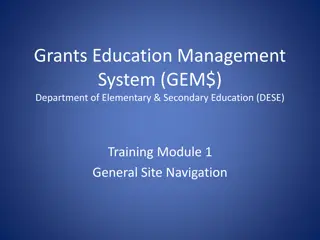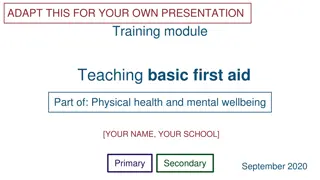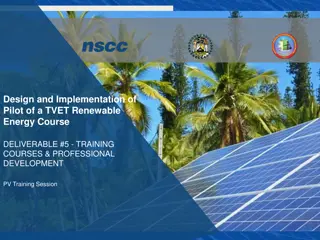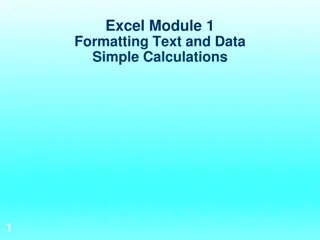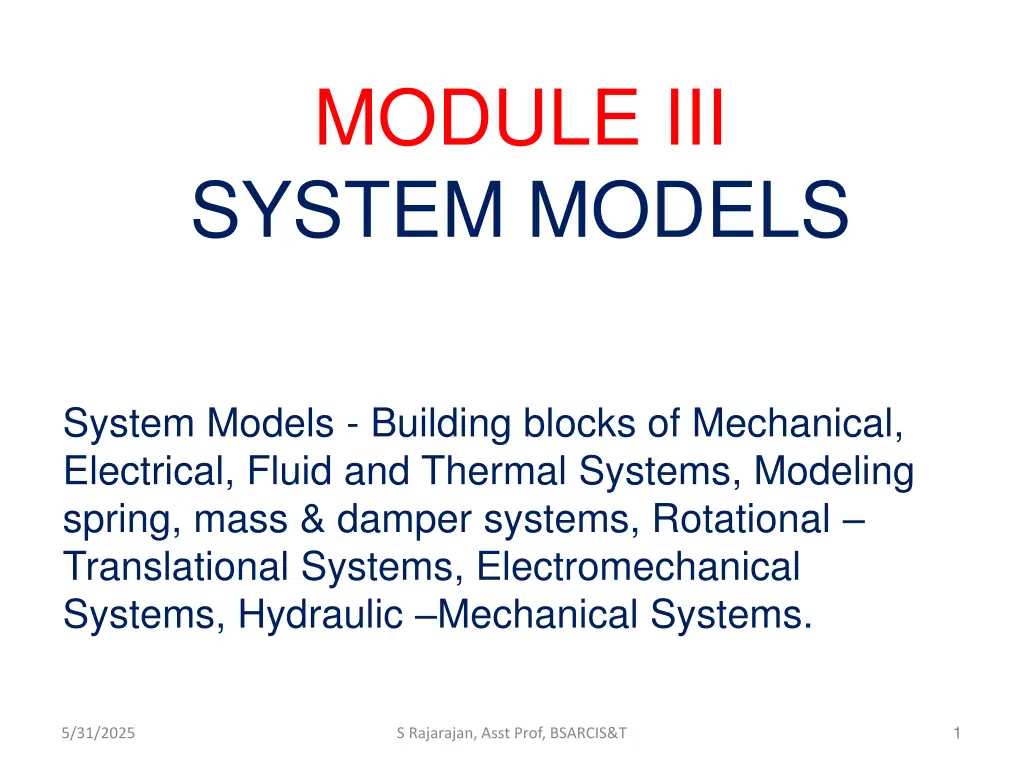
Understanding System Modeling: Building Blocks and Mathematical Models
Explore the world of system modeling, including mechanical, electrical, fluid, and thermal systems. Learn about the importance of mathematical models in representing real system behaviors and the significance of building blocks in creating complex systems. Dive into topics such as lumped parameters and the behavior of systems over time when subjected to disturbances.
Download Presentation

Please find below an Image/Link to download the presentation.
The content on the website is provided AS IS for your information and personal use only. It may not be sold, licensed, or shared on other websites without obtaining consent from the author. If you encounter any issues during the download, it is possible that the publisher has removed the file from their server.
You are allowed to download the files provided on this website for personal or commercial use, subject to the condition that they are used lawfully. All files are the property of their respective owners.
The content on the website is provided AS IS for your information and personal use only. It may not be sold, licensed, or shared on other websites without obtaining consent from the author.
E N D
Presentation Transcript
MODULE III SYSTEM MODELS System Models - Building blocks of Mechanical, Electrical, Fluid and Thermal Systems, Modeling spring, mass & damper systems, Rotational Translational Systems, Electromechanical Systems, Hydraulic Mechanical Systems. 1 5/31/2025 S Rajarajan, Asst Prof, BSARCIS&T
INTRODUCTION How do a system behave w.r.t time when subject to some disturbances????? It takes time to resume to required state Eg: motor starts to rotate in full speed only after a time it takes time to fill required tank level when tap is opened 5/31/2025 S Rajarajan, Asst Prof, BSARCIS&T 2
CONT.. MATHEMATICAL MODEL MATHEMATICAL MODEL a model is required represent real behavior of a system Mathematical model equation describing relation between input & output of a system base for this mathematical model??? Fundamental physical laws governs the behavior of the system 5/31/2025 S Rajarajan, Asst Prof, BSARCIS&T 3
BUILDING BLOCKS A block that is used to build up a system Single property or function Eg: an electrical system may consist of resistor, inductor & capacitor resistor is a separate block that has property of resistance likewise capacitor & inductor are different blocks having property of storing & inducing charges respectively 5/31/2025 S Rajarajan, Asst Prof, BSARCIS&T 4
Cont Mechanical Electrical Fluid Thermal 5/31/2025 S Rajarajan, Asst Prof, BSARCIS&T 5
LUMPED PARAMETERS Eg: an electrical system may consist of resistor, inductor & capacitor resistor is a separate block that has property of resistance likewise capacitor & inductor are different blocks having property of storing & inducing charges respectively Number of electrical circuits can be formed by combining these building blocks in different way Lumped parameter system formed by different blocks these blocks are independent 5/31/2025 S Rajarajan, Asst Prof, BSARCIS&T 6
MECHANICAL BUILDING BLOCKS Models represent mechanical systems Mechanical system made up of spring/dashpot/mass or contains their property alone without real spring/dashpot/mass Input force & output - displacement BLOCK PHYSICAL REPRESENTATION Stiffness of a system SPRING Forces opposing the motion (ie) friction / dampness effect Inertia or Resistance to acceleration DASHPOT MASS 5/31/2025 S Rajarajan, Asst Prof, BSARCIS&T 7
SPRING F = k . x F- force to compress / extend the spring k - stiffness Due to the input force, spring exerts equal force called as spring force but in opposite direction due to Newton s 3rd law of motion S Rajarajan, Asst Prof, BSARCIS&T 5/31/2025 8
DASHPOT To push an object through a fluid or move an object against frictional forces F = c .dx F = c . v c damping coefficient dt Due to the input force, dashpot exerts equal force called as dashpot force but in opposite direction due to Newton s 3rd law of motion S Rajarajan, Asst Prof, BSARCIS&T 5/31/2025 9
MASS F = m .a = m .?2x a - acceleration ??2 Mass always moves in the direction of input force 5/31/2025 S Rajarajan, Asst Prof, BSARCIS&T 10
ENERGY OF MECHANICAL BUILDING BLOCK E = Spring Stores energy & release when returned to original position Mass Stores energy (kinetic energy) & releases when stops moving k . x2 2 = 1 f2 k 2 1 2 .m .v2 E = P = c .v2 Dashpot No energy stored & do not return to its original position dissipates energy - power 5/31/2025 S Rajarajan, Asst Prof, BSARCIS&T 11
ROTATIONAL SYSTEM Torsional Bar / Torsional spring Spring Torsional Damper / Rotary Damper Dashpot Mass Moment of Inertia 5/31/2025 S Rajarajan, Asst Prof, BSARCIS&T 12
Cont 5/31/2025 S Rajarajan, Asst Prof, BSARCIS&T 13
BUILDING A MECHANICAL SYSTEM a) Machine mounted on the ground, b) The chassis of a car moving with wheel on road c) The driver of a car while driving in the road S Rajarajan, Asst Prof, BSARCIS&T 5/31/2025 14
STEPS TO SOLVE PROBLEMS Draw a free body diagram of each mass with the forces associated with it ( spring force & dashpot force are always in opposite direction to input force F ) Write the net force acting on the mass Sign convention: +ve sign for left to right forces - bottom to top forces - clockwise forces Apply Newton s Second law of motion NET FORCE = m . a = m . d2x/dt2 S Rajarajan, Asst Prof, BSARCIS&T 5/31/2025 15
DERIVE AN EQUATION TO RELATE INPUT FORCE F WITH OUTPUT DISPLACEMENT ( X Or ) Refer Notes for Derivation 5/31/2025 S Rajarajan, Asst Prof, BSARCIS&T 16
CONT Refer Notes for Derivation 5/31/2025 S Rajarajan, Asst Prof, BSARCIS&T 17
CONT Refer Notes for Derivation 5/31/2025 S Rajarajan, Asst Prof, BSARCIS&T 18
ELECTRICAL BUILDING BLOCKS Models represent electrical systems Input applied voltage & output voltage across any block given BLOCK PHYSICAL REPRESENTATION Opposition to movement RESISTOR CAPACITOR Store charge INDUCTOR Inducing voltage due to change in magnetic field of coil S Rajarajan, Asst Prof, BSARCIS&T 5/31/2025 19
RESISTOR Potential difference across Potential difference across current current VR= i .R ??=??2 ? VR R i = VR voltage across resistor ; i current ; R resistance ; PR power dissipiated S Rajarajan, Asst Prof, BSARCIS&T 5/31/2025 20
CAPACITOR Potential difference across Potential difference across charge charge ? ? 1 C . i .dt ? = ? ?? ??= VC= dq dt = i = C .d?? ??=1 2 .C .??2 dt VC voltage across capacitor ; i current ; C capacitance ; EC energy stored S Rajarajan, Asst Prof, BSARCIS&T 5/31/2025 21
INDUCTOR Potential difference across Potential difference across rate of change of current rate of change of current ??= L .di dt ??=1 2 .L .?2 1 ? . ?? .?? ? = VL voltage across inductor ; i current ; L inductance ; EL energy stored S Rajarajan, Asst Prof, BSARCIS&T 5/31/2025 22
ANALYSIS OF ELECTRICAL SYSTEM KIRCHOFF S LAW Current law algebraic sum of current at a junction is equal to zero. (more than one loop) Voltage law in a loop sum of voltage across each part is equal to applied voltage. (single loop) ? = ?? + ?? ??= ?? + ?? 5/31/2025 S Rajarajan, Asst Prof, BSARCIS&T 23
STEPS TO SOLVE PROBLEMS Draw the circuit diagram Input is applied voltage (v) & output will be given in the question as Vc (voltage across capacitor) or VR (voltage across resistor) or VL (voltage across inductor) If single loop : use voltage law (? = ?? + ??+ etc ) Convert VR , VL, Vc everything in terms of current equation & then substitute i current with output voltage ( for example if output voltage is VC then write all i interms of VC ) 5/31/2025 S Rajarajan, Asst Prof, BSARCIS&T 24
CONT If more than one loop: Use current law (??= ?? + ??) Convert all i (current) in the equation in terms of output voltage suitably Rearrange all the terms in such a way input voltage on one side & output voltage on other side 5/31/2025 S Rajarajan, Asst Prof, BSARCIS&T 25
DERIVE A RELATION BETWEEN INPUT VOLTAGE AND OUTPUT VOLTAGE Refer Notes for Derivation 5/31/2025 S Rajarajan, Asst Prof, BSARCIS&T 26
CONT Refer Notes for Derivation 5/31/2025 S Rajarajan, Asst Prof, BSARCIS&T 27
ELECTRICAL & MECHANICAL ANALOGY Spring Capacitor Resistor Dashpot Mass Inductor 5/31/2025 S Rajarajan, Asst Prof, BSARCIS&T 28
FLUID BUILDING BLOCK FLUID BUILDING BLOCK Hydraulic liquid incompressible Relation between pressure / height and volumetric flow rate Pneumatic gas - compressible Relation between pressure and mass flow rate 5/31/2025 S Rajarajan, Asst Prof, BSARCIS&T 29
HYDRAULIC BUILDING BLOCKS BLOCK PHYSICAL REPRESENTATION Opposition to flow HYDRAULIC RESISTANCE HYDRAULIC CAPACITANCE HYDRAULIC INERTANCE Store as potential energy Accelerate a fluid by pressure difference 5/31/2025 S Rajarajan, Asst Prof, BSARCIS&T 30
HYDRAULIC RESISTANCE P1 ?2= q .R ?1 ?2 R q = ??=1 ? (?1 ?2 )2 Orifices, valves, nozzles and friction in pipes can be modeled as fluid resistors P1 & P2 pressure @ 1 & 2 q volume flow rate R hydraulic resistance PR power dissipiated 5/31/2025 S Rajarajan, Asst Prof, BSARCIS&T 31
HYDRAULIC CAPACITANCE Hydraulic cylinder chambers, tanks, and accumulators are examples of fluid capacitors ?1 ?2= C .?? ?1 ?2=1 ??=1 2 ? .(?1 ?2 )2 ?? ? . ?1 ?2. ?? q1 & q2 volume flow rate @ inlet & outlet P1 & P2 pressure @ 1 & 2 C hydraulic capacitance EC energy stored S Rajarajan, Asst Prof, BSARCIS&T ? C = Refer Notes for Derivation .? 5/31/2025 32
HYDRAULIC INERTANCE ?1 ?2= I .?? ?1 ?2=1 ??=1 2 ? .(?)2 I =?. ? ?? ? . ?1 ?2. ?? Long pipes are examples of fluid inertances q1 & q2 volume flow rate @ 1 & 2 P1 & P2 pressure @ 1 & 2 C hydraulic inertance EI energy stored S Rajarajan, Asst Prof, BSARCIS&T Refer Notes for Derivation 5/31/2025 33
PNEUMATIC BUILDING BLOCKS BLOCK PHYSICAL REPRESENTATION Opposition to flow PNEUMATIC RESISTANCE PNEUMATIC CAPACITANCE PNEUMATIC INERTANCE Store as potential energy Accelerate a gas by pressure difference 5/31/2025 S Rajarajan, Asst Prof, BSARCIS&T 34
PNEUMATIC RESISTANCE P1 ?2= R . ?1 ?2 R = Orifices, valves, nozzles and friction in pipes can be modeled as fluid resistors ??=1 ? (?1 ?2 )2 P1 & P2 pressure @ 1 & 2 mass flow rate R pneumatic resistance PR power dissipiated S Rajarajan, Asst Prof, BSARCIS&T 5/31/2025 35
PNEUMATIC CAPACITANCE 1 2= ( ?1+ ?2 ) .?? chambers, tanks, and accumulators are examples of fluid capacitors Hydraulic cylinder ?? 1 ( ?1+ ?2 ) . 1 2. ?? ?1 ?2= ??=1 2 ( ?1+ ?2 ) .(?1 ?2 )2 1 & 2 mass flow rate @ inlet & outlet P1 & P2 pressure @ 1 & 2 C1 pneumatic capacitance (change in volume) C2 pneumatic capacitance (compressibility) EC energy stored ?1= .?? ?? ? ?.? Refer Notes for Derivation 5/31/2025 ?2= S Rajarajan, Asst Prof, BSARCIS&T 36
PNEUMATIC INERTANCE ?1 ?2= I .? 1 2=1 ? . ?1 ?2. ?? ??=1 2 ? .( )2 I =? ? ?? Long pipes are examples of fluid inertances 1 & 2 mass flow rate @ 1 & 2 P1 & P2 pressure @ 1 & 2 I pneumatic inertance EI energy stored S Rajarajan, Asst Prof, BSARCIS&T Refer Notes for Derivation 5/31/2025 37
Derive a relation for height of the tank (change in flow rate is slow / neglect inertance) Refer Notes for Derivation 5/31/2025 S Rajarajan, Asst Prof, BSARCIS&T 38
DERIVE A RELATION FOR THE FLUID LEVEL IN TWO CONTAINERS ( CHANGE IN FLOW RATE IS VERY SLOW ) Refer Notes for Derivation 5/31/2025 S Rajarajan, Asst Prof, BSARCIS&T 39
DERIVE A RELATION FOR THE VARIATION ON PRESSURE 2 DUE TO PRESSURE 1 ( CHANGE IN FLOW RATE IS VERY SLOW ) Refer Notes for Derivation 5/31/2025 S Rajarajan, Asst Prof, BSARCIS&T 40
THERMAL BUILDING BLOCKS BLOCK PHYSICAL REPRESENTATION Opposition to flow of heat THERMAL RESISTANCE THERMAL CAPACITANCE Store of internal energy 5/31/2025 S Rajarajan, Asst Prof, BSARCIS&T 41
THERMAL RESISTANCE T1 ?2= R . q ?1 ?2 q = R CONDUCTION CONVECTION ? 1 R = R = k A h A T1 & T2 temperature @ 1 & 2 q rate of flow of heat R thermal resistance k thermal conductivity h coefficient of heat transfer A area of cross section L length of pipe 5/31/2025 S Rajarajan, Asst Prof, BSARCIS&T 42
THERMAL CAPACITANCE ?1 ?2= C?? ?? ? =1 ? ?1 ?2. ?? ??= C.T q1 & q2 heat flow rate @ inlet & outlet T temperature C thermal capacitance m mass of the object c specific heat capacity EC energy stored C = ?.? 5/31/2025 S Rajarajan, Asst Prof, BSARCIS&T 43
DERIVE A RELATION BETWEEN THE TEMPERATURE OF THERMOMETER AND LIQUID Refer Notes for Derivation 5/31/2025 S Rajarajan, Asst Prof, BSARCIS&T 44
DERIVE A RELATION TO SHOW HOW THE ROOM TEMPERATURE CHANGES WITH TIME Refer Notes for Derivation 5/31/2025 S Rajarajan, Asst Prof, BSARCIS&T 45
COMBINED COMBINED BUILDING BLOCK BUILDING BLOCK Many systems in real life involves combination of more than one discipline: rotational & translational building blocks (Eg: rack & pinion) Electrical & mechanical building blocks (Eg: potentiometer , dc motor) Hydraulic & mechanical (Eg: movement of piston by a valve) Refer Notes for Derivation 5/31/2025 S Rajarajan, Asst Prof, BSARCIS&T 46
5/31/2025 S Rajarajan, Asst Prof, BSARCIS&T 47




